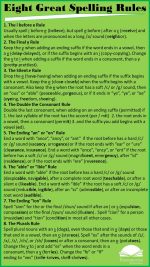Top Twelve Spelling Trends and Fads
Spelling instruction certainly has had its share of crazy instructional trends and fads. As an author of two spelling books, a reading specialist, and a teacher of elementary school, middle school, high school, and community college students, I have seen my fair share of them over the last thirty years.
For example, during the height of the whole language movement of the 1980s, California stopped adopting spelling programs and refused to fund the purchase of spelling workbooks. Principals were even encouraged to confiscate spelling workbooks from veteran teachers.
In the spirit of factcheck.org, I have listed and rated a dozen of the most popular instructional spelling trends and fads over the last thirty years as “TRUE” or “FALSE,” in terms of recent spelling research.
1. Tracing letters in sand helps students remember how to spell words. Advocates feel that this practice stimulates the visual memory.
FALSE Spelling is not a visual or graphic skill that relies upon visual memory.
2. Spelling can be improved via neuro-linguistic programming in which pictures and letters of words are impressed in one’s head and the student learns words by spelling them backwards.
FALSE While picturing whole words may provide short term benefit, such as memorizing for the weekly spelling test, it is not an efficient strategy for long term conventional spelling acquisition.
3. Spelling is a natural skill that improves with wide exposure to and practice in reading.
FALSE Although there is a positive correlation between high reading comprehension scores and conventional spelling ability (Stanovich and Cunningham 1992), there is no established causal connection.
4. Spelling is hereditary.
HALF-TRUE “The relatedness of reading and spelling may be understood in terms of differences in underlying underlying verbal ability, which in turn may be partly determined by hereditary factors (Pennington 1991).”
5. Spelling ability is related to phonics ability.
TRUE Once students have sufficient practice in how words work at the phoneme level and are able to blend and segment words verbally, they can apply this knowledge at the symbolic level for both reading and spelling.
6. Inventive spelling helps students learn how to spell.
TRUE Good spellers problem-solve which letters and combinations best represent sounds. Spellers who practice application of the sound-spelling connections and the rules of spelling become less teacher, dictionary, and spell-check dependent. Too much focus on spelling correctness on rough drafts may inhibit word choice. Spelling correctness on final drafts is a must.
7. Spelling instruction should be differentiated according to learning styles or modalities.
FALSE Such instructional strategies as recording spelling words for auditory learners, practicing with magnetic letters for kinesthetic learners, and rehearsing with flash cards for visual learners do not enhance spelling acquisition more for some learners than others.
8. Spelling is a developmental skill that can be categorized into cognitive spelling stages. Advocates feel that students can be challenged to progress through these spelling stages with differentiated instruction and word play.
TRUE Popularized by the authors of the popular Words Their Way: Word Study for Phonics, Vocabulary, and Spelling Instruction (Bear et al, 2000) and the widely distributed Qualitative Spelling Inventory, the authors advocate spelling sorts, word study and games and de-emphasized the traditional pretest-study-posttest form of spelling instruction.
9. Studying the shapes of letters and grouping letters for memorization by letter shape aids long-term memory. Advocates claim that this instructional approach is beneficial for students with visual processing challenges.
FALSE Because spelling is primarily an auditory skill of matching letters to sounds, the shapes of the letters are irrelevant to spelling acquisition.
10. Left-right brain strategies help spelling. Advocates feel that the right hemisphere can be stimulated and spelling improved by using wrist bands or looking up and left to memorize spellings.
FALSE There is no evidence that cueing the brain will improve spelling or linguistic ability.
11. What works for one student to develop conventional spelling ability does not work for every student. Not all students learn how to spell in the same way.
FALSE Effective spelling instructional strategies work for every student. Differentiated instruction should derive from diagnostic assessment data.
12. Spelling is basic memorization. Using pictures can help students memorize spelling words.
HALF-TRUE Although some words must be mastered as “sight spellings” because they are phonetically irregular, and although many words do not follow the conventional spelling rules, it is still beneficial to apply the alphabetic code to spelling. At least 50% of spellings directly match their sounds.
A Model Grades 3-8 Spelling Scope and Sequence
Preview the Grades 3-8 Spelling Scope and Sequence tied to the author’s comprehensive grades 3-8 Language Strand programs. The instructional scope and sequence includes grammar, usage, mechanics, spelling, and vocabulary. Teachers and district personnel are authorized to print and share this planning tool, with proper credit and/or citation. Why reinvent the wheel? Also check out my articles on Grammar Scope and Sequence, Mechanics Scope and Sequence, and Vocabulary Scope and Sequence.
FREE DOWNLOAD TO ASSESS THE QUALITY OF PENNINGTON PUBLISHING AMERICAN ENGLISH AND CANADIAN ENGLISH SPELLING PROGRAMS. Check out these grades 3-8 programs HERE. Administer my FREE comprehensive Diagnostic Spelling Assessment with audio file and recording matrix. It has 102 words (I did say comprehensive) and covers all common spelling patterns and conventional spelling rules. It only takes 22 minutes and includes an audio file with test administration instructions. Once you see the gaps in your students’ spelling patterns, you’re going to want to fill those gaps.
Get the Diagnostic Spelling Assessment, Mastery Matrix, and Sample Lessons FREE Resource:
![]()
Literacy Centers, Reading, Spelling/Vocabulary, Study Skills, Writing







